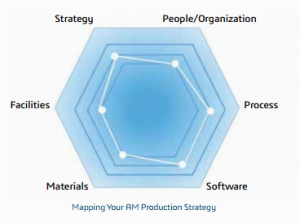Mike Vasquez, Ph.D., CEO, 3Degrees, LLC

The processing and materials technology for 3D printing has continued to evolve and improve, enabling significant expansion of production use cases for the technology. As adoption of the technology moves beyond its prototyping heritage, the needs of companies deploying the technology are rapidly changing, too. No longer are 3D printed parts just for the use and testing of R&D or innovation teams; printed products are now finding a number of end uses that bring them into the “for commercial use” realm. As more applications become financially and technologically feasible, a real effort needs to be undertaken to match the sophistication of existing manufacturing processes for documenting critical variables, process characteristics, materials and inspection. Having worked with organizations in the aerospace, automotive, medical and consumer products industries as they operationalize 3D printing for production parts, we advise keeping in mind three key things as you make the jump to production.
Sweat The Facility Startup Details Once you invest $10,000, $100,000 or $1 million dollars into a machine, you quickly will realize that much more is needed to create a safe, effective 3D printing capability. Additional cost items include materials, post-processing equipment, safety equipment and training. This can be especially true for metal 3D printing technologies, as once the part is built in the machine it still may require heat treatment, removal from a build plate, surface treatments and polishing before it’s finished. As you go down this path, having internal alignment on the business case for the created parts as well as how the organization will operate can make the difference between getting ramped up quickly and costly delays. We often work with companies at these early stages to do a Production 3D Printing Readiness evaluation that takes a look at the following categories: AM Strategy, People/Organization Structure, Processes, Materials, Software, and Facilities. It is important to make sure that these topics are discussed and thoroughly thought-through during your production planning.
Designing For 3D Printing Is Critical If your idea of a great application for 3D printing is to create a screw or a standard bolt for your business, you probably don’t need to invest in the technology. The biggest advantage that 3D printing has over other manufacturing technologies is the fact that you can create complexity in your parts without adding cost. This means that in order to use 3D printing effectively, you need to be comfortable redesigning your parts to take advantage of this. Companies often struggle trying to achieve their return on investment for 3D printing because it requires going back to the drawing board, literally.
Develop A Smart Workflow To Manage Quality Another challenge that we’ve seen as companies start to operationalize their 3D printing capabilities for production is trying to formalize a workflow that ensures both efficiency and quality part development. There are a number of factors that impact part quality throughout the process including design, material feedstock, processing, post-processing and inspection. Within each of these broad categories there could be dozens of variables that need to be documented and controlled. This is made more complex by the fact that the development of industry specifications and standards is still in its infancy. The bottom line is that companies—large and mid-size alike—are just starting to incorporate this technology into their production processes. As a result, there’s still a lot to learn…and a lot of opportunities for companies who do it right to create competitive advantages.
About The Author Dr. Mike Vasquez is a 3D printing expert specializing in pushing the boundaries of advanced 3D printing technology. He is the Founder of 3Degrees, a Chicago-based consulting company focused on helping organizations maximize their investment in the technology. He completed his Ph.D. in Additive Manufacturing at Loughborough University and received both his Bachelors and Masters from MIT in Materials Science and Engineering. Recently he published a best practice guide titled How to Make 3D Printing Work for You and Your Business.
For more information, visit 3Degrees.
This article was originally published in the September 2017 issue of SIMULIA Community News magazine.
